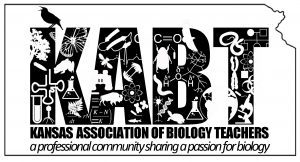Fall 2012 Fall Meeting Program and Reminder
The Fall 2012 KABT meeting is just over a week away. Several members have stepped up and volunteered to present. Should be a great time to meet, get reacquainted and geek out about biology. A whole lot of sharing of ideas, problems and solutions happen at these meetings. The meeting start with registration at 8:30 at the KU Field Station north of town. Registration is $15 to cover facilities and noon meal. Hope to see you there.
Each Presentation is scheduled for 40 minutes with a 5 minute break between presentations. Here’s how the day breaks down.
8:30–>9:00
Registration (Breakfast is on your own but we do plan on providing lunch)
9:00–>9:40
Enzyme kinetics (inquiry adaptations & Excel modeling) Michael Ralph (Olathe East High School)
Exploring how to encourage student inquiry and build deep content understanding
9:45–>10:25
Lessons from the BSCS AP Biology Leadership Academy Lin Andrews (Goddard Eisenhower High School)
Techniques and Tips for taking an inquiry investigation to the next level with formative assessment techniques, argumentation and connecting to big ideas.
10:30–>11:10
Tadpole and Fairy Shrimp Culture in the Classroom Mike Grose (KU Museum of Natural History)
Presentation abstract:
Tadpole shrimp (Triops) are important ecological links in semi-arid and ephemeral pool habitats. They need to complete their entire life cycle within weeks and lay hundreds of eggs for the next generation. This presentation will cover everything you wanted to know about raising these fascinating vernal pool dwellers. I’ll cover equipment you may already have, ideal hatching conditions, what they need to eat, and how to raise them to egg laying adults. Their quick life cycle may make them ideal experimental animals for behavior projects, science fairs, or just fun demonstrations for animal diversity. I have dried out eggs, so if you interested you can leave and start your own colonies. (If you or your students are really interested in raising them, let me know before and I’ll prepackage a starter kit for you). E-mail me at mjg@ku.edu
11:15–>11:55
Algae and Biofuels Classroom Research Andrew Ising and Scott Sharp (Junction City and De Soto)
We will aim to show how microalgae can be used in a variety of classes and at many different levels to demonstrate concepts in Microbiology, Ecology, Biotechnology and Engineering. We’ll discuss cheap ways to measure algae densities, and the best way to keep it alive and thriving.
12:00–>1:25 Lunch (burgers, veggie burgers, brats), Poster Presentations, Track Tube Demonstration, short Business Meeting
1:30–>2:10
Halo Bacteria as Model Organism in the Classroom Kelley Tuel (Emporia State University)
Highlighting attributes that make the extremophile Model Microbe, Halobacterium sp. NRC-1 an exciting tool for safe and versatile classroom use.
2:15–>2:55
California Blackworm Investigation Paula Donham (Olathe East High School)
To explore the impact of treatments on the pulse rate of the worm Lumbriculus variegatus while refreshing and refining student understanding of experimental design with a focus on recognizing and minimizing experimental bias. Adapted from Dr. Charles Drewes, Iowa State University (http://www.eeob.iastate.edu/
3:00–>3:40
Cricket Frog Citizen Science Dan Smalley (Augusta High School)
The goal of this presentation is to describe and inspire teachers to have students help to gather data about cricket frog populations. I will be describing a project I did last year with my students where we collected data about a population of cricket frogs near our school. I want to make a proposal that other classes join in and study the frogs too. In several other states these frogs have been used to describe environmental pollutants, as well as emerging evolutionary patterns. What patterns may our students find if they too looked at data about these frogs from Kansas?
3:45–>4:30
Planting Science Bill Welch (Wichita Northwest)
How to use the Plantingscience.org website and integrating it into the classroom setting.
